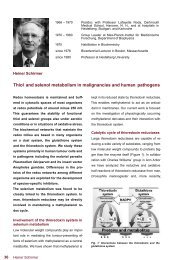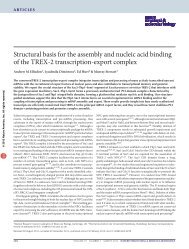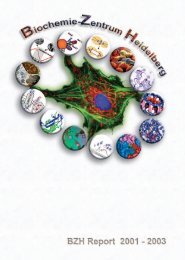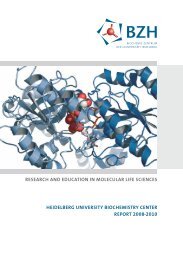Biochemie-Zentrum der Universität Heidelberg (BZH)
Biochemie-Zentrum der Universität Heidelberg (BZH)
Biochemie-Zentrum der Universität Heidelberg (BZH)
Create successful ePaper yourself
Turn your PDF publications into a flip-book with our unique Google optimized e-Paper software.
Funding<br />
Son<strong>der</strong>forschungsbereich (SFB) 638:<br />
Dynamics of macromolecular complexes in biosynthetic transport<br />
Chairman: Felix Wieland, <strong>Biochemie</strong>-<strong>Zentrum</strong> <strong>der</strong> <strong>Universität</strong> <strong>Heidelberg</strong> (<strong>BZH</strong>)<br />
Cells are highly dynamic structures that can be<br />
compared with factories full of sophisticated ma-<br />
chines. In the last decades many individual parts<br />
of these machines have been identified and char-<br />
acterised. In the years to come the most excit-<br />
ing challenge will be to decipher how individual<br />
building blocks are put together in variable ways<br />
to perform the cell´s dynamic functions. This is<br />
done in an iterative way: one first tries to com-<br />
bine the single parts to functional assemblies;<br />
once an assembly is defined functionally, such<br />
assemblies are combined to even higher aggre-<br />
gates at a next layer of complexity, again func-<br />
tionally characterised, and so on. With a hundred<br />
thousand or so different proteins that build up a<br />
human cell, and up to 200 parts comprising a<br />
macromolecular complex (a functional unit), it is<br />
evident that there is still a long way to go in or<strong>der</strong><br />
to completely un<strong>der</strong>stand not only the compositions<br />
of all possible functional units, but also their<br />
interplay, i.e. their dynamics. With this knowledge<br />
complete, we would un<strong>der</strong>stand the molecular<br />
basis of life, and to prove our un<strong>der</strong>standing, we<br />
would have to reconstitute a living cell from its<br />
defined building blocks. This would have to occur<br />
not only by adding each component in exactly<br />
the correct concentration, but also in a defined<br />
sequence, because of their dynamics many of the<br />
assemblies can only function correctly in a timedependent<br />
manner. Needless to say that such a<br />
task could be solved only by the activity of many<br />
scientists worldwide, and final success, if possible<br />
at all, lies in the far future.<br />
Along this way, the SFB 638 “Dynamics of Macromolecular<br />
Complexes in Biosynthetic Transport”<br />
has initiated an interdisciplinary approach to investigate<br />
the structural and dynamic behaviour of<br />
complexes of up to 100 or so components with-<br />
in a cell. Even if none of the scientists involved<br />
is likely to reach the final goal, we believe that<br />
many important lessons can be learned during<br />
this journey. The expertise existing in <strong>Heidelberg</strong><br />
has led us to focus our research on biosynthetic<br />
transport. In this context we use the term dynamics<br />
at two levels: I) dynamics of macromolecular<br />
complexes (e.g. their conformational change, or<br />
their assembly and disassembly), and ii) the dynamics<br />
of the interplay of macromolecular complexes<br />
during their further assembly or disassembly<br />
to form functional subcellular structures<br />
(e.g. formation and transport of a pre-ribosomal<br />
assembly through the nuclear pore, the formation<br />
or disassembly of a coated membrane carrier, or<br />
the formation and transport of a virus particle).<br />
Biosynthetic transport is a cellular housekeeping<br />
function of special interest with respect to medical<br />
research, because many congenital diseases<br />
are caused by defects in transport machinery<br />
and biosynthetic transport is exploited at various<br />
steps by pathogenic viruses for productive infection<br />
and synthesis of viral progeny. Thus, our SFB<br />
brings together research groups using structural,<br />
cell biological, biochemical, molecular biological<br />
and virological methods and analysing various<br />
model organisms, from bacteria via yeasts to<br />
mammalian cells. Our collaborative approach<br />
allows integration of colleagues coming from different<br />
fields in the life sciences, driven by their<br />
common research interest. As a result, exchange<br />
between the groups of a wide range of knowledge<br />
and methodology is achieved naturally, and this,<br />
combined with the common interest, fosters creativity<br />
and at the same time strengthens a competent<br />
and critical view to evaluate results.<br />
Funding<br />
49







